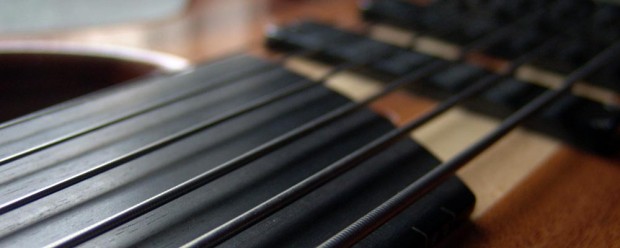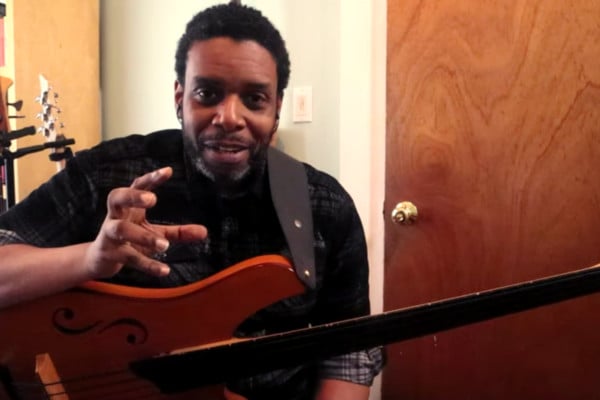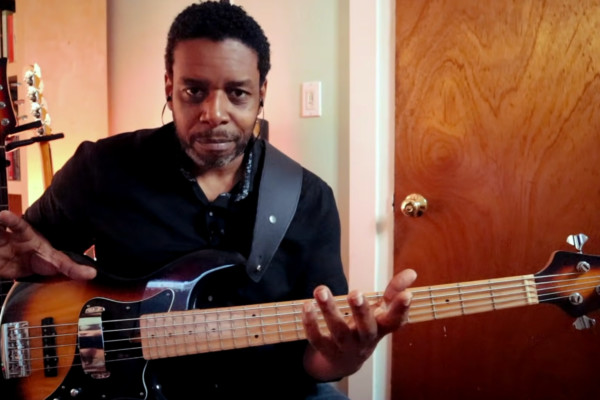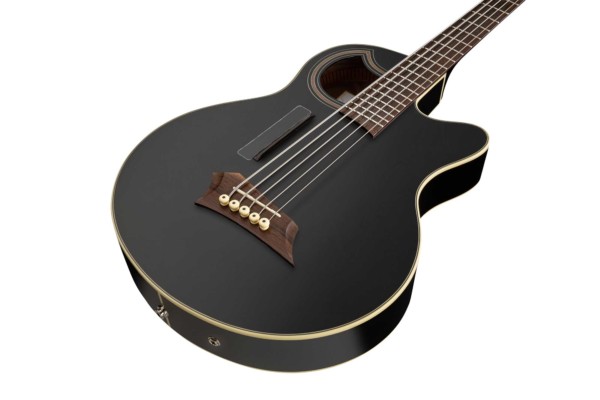A Guide to Making the Switch Fretless Bass

Q: I’ve just removed the frets from my first bass, and this is my first experience with a fretless bass. What advice do you have to start out?
A: There are two areas of focus for making the switch. At a glance, these might seem to contradict each other, but one applies to practicing and one applies to performance.
Fretless Bass Practice:
- Try playing scales or melodic patterns slowly through a tuner. This can help you to get a feel for where your finger should really be for the note to be perfectly in tune.
- Pay close attention to your left hand technique. Now, more than ever, it is important for you to have good hand position and control over your finger spacing (one finger per fret is ideal)
Fretless Bass Performance (aka; in real life)
Don’t worry too much about being in tune perfectly, every second of the song.
Kai Eckhardt once told me that his intonation improved greatly when he realized that a fretless could be used more like a human voice (with inflection and variation of pitch). Once he “allowed” himself to slide in and out of notes a little bit, his intonation actually improved because he now heard the slight variations as inflection, rather than “just plain wrong”.
Clearly, you do want to control when you are in tune, but give yourself the freedom to be human as you develop. That release from anxiety will allow you to perform better and more freely.
I’d really like to hear from all of you too. Fretless peeps, what has helped you along in your quest for intonation bliss? Post your thoughts in the comments.
Photo by dimis dimopoulos.
Have a question for Damian Erskine? Send it to [email protected]. Check out Damian’s instructional books, Right Hand Drive and The Improviser’s Path.




Both the practice tips you give seems good (imo) I used a chromatic tuner a lot in the beginning. But what really turned out to be the important part for me, was when I understood that I have to listen to what I’m playing in another way than when playing fretted. A cello teacher I know once said “anyone who can sing in pitch can learn to play the cello” – and then also fretless bass. Just remember to listen to what you are doing and play accordingly.
If you really want to train your ears, play along with a drone. I’ve found the “The Tuning CD” to be invaluable, but there are lots of options out there. Just put it on, and play along (scales or whatever you like) in whatever key feels good. The benefit to this method is that you hear ‘beats’ or a a warble in the tone when you’re off. http://itunes.apple.com/ca/album/the-tuning-c.d.-a-440/id319589901
I don’t agree much with using the tuner. A very well know and respected bassist was so paranoid of his intonation on upright that he recorded in the studio while watching a tuner. I regularly switch back and forth between fretted and fretless. I started that many years back. I had one Jazz bass that was converted to fretless – so the lines were there. I found another one where the neck was as close to duplication as possible. I would warmup a bit on the fretted and then complete warming up on the frettless. A royal pain early on but well worth it. It also helps to learn what the differences are in intonation – find a piano tuner and let him explain.
I used a looper, looping a few chords on a fretted bass then do some basslines on fretless and try and make it sit. Live, watch the fingers on the fret markers.
I have learned( through playing my own fretless bass) that if you transfer the bend in your wrist to the bend in your elbow(by raising the headstock higher than you normally would play a fretted bass), Your finger pressure, reach, and above all, your accuracy will improve greatly!
I have found the key to my staying in tune (besides my ears of course…) is keeping the headstock higher as you have said. It helps me “visualize” the fretline more accurately on an unlined fretboard…
When it come to fretless playing, you have to play more with your ears that your eyes. That means your fretboard hand will develop really good muscle memory as it travels the neck. You may glance on occassion for reference points, but, for the most part, your ears and fingers carry your through. Personally, I find I stray from being in tune more often when I spend too much time “watching” what I play.
I found it easier to play fretless bass with a non lined fingerboard. With the lines, you tend to “play by your eyes” more. It will be like playing a defretted bass, if you got my point. Also – start out slowly! Don’t rush into Donna Lee untill you have passed the ballads in your Real Book…
I like playing the fretless. I look at the lines only during guitar solos, when I need to be in tune with the guitar. When I’m singing, I keep my eyes closed.
Love the aesthetics of a blank plank, but if I’m truly “on” my eyes are closed anyway.
Unlined seems to work for a lot of people but it didn’t for me, which is a bit odd because I play upright also. But I started with lines and stuck with it. I look at the fingerboard a lot whether fretted or fretless – it’s not necessarily related to intonation. Main point is that with fretless, your left hand technique must be perfect, with fretted a certain amount leeway is possible.
You would think that the transition from upright bass to an unlined fretless bass guitar would be easy and natural, but a lot of upright players get confounded due to the difference in scale length.
As a side note, my tone on fretted bass improved a lot from playing frettless for so many years. Improved left hand accuracy will lead to the best tone on fretted also.
do they make partly-lined? I’d think a line or some kind of marking at the octave and maybe another at the fifth (7th fret) would be handy, especially for a beginner.
I have an old Peavey Foundation with lines stained dark. They are slightly lighter than the black-stained rosewood fingerboard. From a distance the neck looks unlined, smooth, and clean – like an upright. It forced me to develop my ear better too. I now have an interest in getting a newer fretless model. I do I will go with an ebony fingerboard with side-dots-only, i.e., an elegant, smooth, uniform neck.
Centipede Farmer Yes, there are some with the Fender standard dots or blocks without lines.
I guess I have a bit of a weird story. I was originally a guitarist who had to trade for bass when the bassist left my band, that was about 15 years ago. I played on a Jazz Bass that wasn’t mine for a whole year. Then I had the chance to play on a friend’s fretless and I immediately fell in love with the intense intonation capabilities of the instrument: and bought a brand new Stringray 5 fretless. It’s been my only bass for all those years and I’ve played in many different genres – metal, prog, jazz, blues, rock, funk, disco… Still today I don’t own a fretted bass and do all my giggin’ with the stringray 5. People called me crazy for doing such a jump (buying a fretless and keeping it as your only bass), but it’s been working great so far!
As for tips, I never used a tuner up to practice – I prefer using my ear and play along recorded stuff. Depending on the color of the chords, you may want to play that F# a little above or under… Then when you get in concerts you’re not always looking at the neck, but rather always listening to what’s happening. Much better experience in my opinion ;).
Now I miss real slap bass, I might get a fretted just for that!
In fact, here’s another tip. Look at your left hand when you’re practicing. If you naturally have an angle you can’t get rid of in your wrist, it may be worth fine-tuning the harmonics to follow this natural angle. For instance, play the standard 1-5-1 power chord and look at your last 2 fingers: they’re probably not on a straight line. Because of this I created a subtle “angle” in my harmonics to compensate for it: playing in tune feels more natural this way, as I have to play the high strings a little higher than the low strings to be in tune.
I’d never thought of the tuner idea (they weren’t around in the late 1970s when I acquired my first fretless). I think it’s good advice from Kai Eckhardt not to be too paranoid about perfect intonation; a subtle glide or slide to a note (or a major or minor third) can really add to a performance. When you’ve got your left-hand technique as accurate as possible, let your fingers and ears do the work for you; if you’re relaxed and enjoying playing the fretless, and using it to enhance the musical quality of the piece you’re playing, the chances are the audience and other musicians will too. Some really helpful advice here though, great to have a forum to discuss all this. Now I’d better do some work!
This is more like a question. I currently play a Marcus Miller Signature Jazz. I’ve been giving some very serious thought to fretless for jazz work. What would be a 4 string fretless that wouldn’t cost me a mint but be a quality good sounding bass I could start with?
There is a Squire model that is a 2-tone sunburst with Seymour Duncan PUs. As with most Squires, you need to check the individual instrument very closely as the quality varies a lot. I’ve got one that works great for me, since I don’t play fretless nearly as much as I did 10 ago. All Guitar Centers seem to have this model.
I made the switch to fretless by accident. I made a blind purchase thru ebay that wasn’t properly described but once I received my first lefty 5 string by mail I really didn’t want to go thru the trouble of returning it. I asked a few more experienced folk about technique and any advice to help me. What it came down to was just hours of practice and really learning about the slight variations on placement. I ended up with a funky folk band a couple years later and it fit so well with the rootsy sound! it became my primary instrument for about 6 years.i’m really thankful for the accidental introduction to the fretless bass. I feel much more comfortable with a fretted instrument.
if has lines, play them if not its all about feel
James Seyfert It does have lines which was great for learning and teaching myself what it should feel like for proper position. now, since i primarily play by ear anyway, it’s all about how it sounds. the placement becomes natural after a few years. and like i said, now i’m much more comfortable with fretted instruments. slap bass is a cakewalk after you’ve had to watch for even the slightest placement variation when you don’t have the frets as guides.
Great topic! First I’d say: Please do worry a lot about intonation!
Fretless bass is more like a cello: There is no easy way. Slides and vibratos should have a musical reason, and should never hide bad intonation. But still, there is no perfect intonation on fretless, it’s an ideal we all strive for…
Muscle memory helps a lot. To build it up, you have to practice a lot. Drones are very good. Recording and listening back, too. Steve Bailey’s book is killer: The best exercises around.
Fret lines: There are very controversial opinions about fretlines. I think there are no rules about them.
4-finger technique: I don’t agree totally. I have small hands, and I have to use double bass technique on the lower notes. However, whatever choice you make, it has to be conscious!
In my experience, it’s better to try and find a fretless bass that’s the same as your current fretted bass….that’ll cut down on some of the learning curve because of familiarity of feel alone! My fretted bass is a Lakland 55-94.They same day I got my 55-94 fretless, I had to play it! It wasn’t as horrible an event I thought it would be because the spacing was identical and the feel was familiar.
The concentrated practice of scales, modes, arpeggios, and riffs are necessary to develop good playing and intonation technique, especially on a non-fretted or wind instrument. I am not a great bass player but have been around a while and have been playing fretless bass exclusively since the mid 70’s getting a thick, string bass sound and a lot of initial punch. I have worked many styles using the same bass. It’s all in the fingers. There is a terrific prejudice out there thinking that all fretless bass players have a mid-rangy, mooo sound and that we all play out of tune. You know who you are you six string guitar players bending your notes all over the place looking to emote or something. We are lucky today to have access to cheap and efficient chromatic tuners and I now use one when practicing exercises. Checking is good but many times my ear tells me to not be right on to the tuners idea of pitch. Excellent non-fretted string players and wind players understand that intonation is relative to the preceding note and the next note in the sequence, relative to the musical idea. Listen to Yo-Yo Ma bend intonation to move the music. Use your ear and use the incredible versatility of the fretless instrument to make exciting music.
This is cool how fretless is a really generous community with info.
As far as the tuner thing, you have to always accommodate the other players, especially vocalists and pianists. Intonation adjustments are always being drummed into brass, woodwind, and string players, and guitar intonation is tricky. I remember being confused the first time I put a digital tuner on a digital piano and seeing it 15+ cents sharp in upper registers, then I read about how piano tuners have to octave stretch. So, aside from piano players, you’ll probably always be playing with players who are adjusting their intonation, learning equal temperament is a good base.
yes its true! it sound like human voice… justi finish the fretless process of my jazz bass.
I wouldn’t so much want to “make the switch” to fretless, as _add_ it to my abilities. A lot of valuable insight here from from fretless players. Good article, great comments!
I have played scale with a tuner as well it has really helped my hearing where I should be on the fretless bass. it has a great tone.
All great information, excellent thread. When I switched over to fretless I played nothing else for the first year. After that I found that when I occasionally played my fretted bass my expression and creativity were vastly improved. The fretless was so much more expressive.
I agree that its very vocal sounding, also more like a horn.
LISTEN! record your playing, ear training, really feel your bass so you can just grab an octave or 5th and just hear it roar. I got my frets pulled and finger board glued finish and though it would be a great idea to just take that on tour… the first 3 shows sounded dreadful… but by the end of the 14 dates, my playing was SOO improved… on a fretted as well. bottom line for any musician is “you gotta be able to hear around corners”.
don’t depend on a tuner for life, its the other musicians your playing with. I’ve heard out of tune guitar players, and played in pitch with them. After the tune, I call them out (knowing I’m in tune of course) and they’re all like “WOW! your know my D string is out, how’d you get so good?”
you say I got skills to pay bills
I think it’s funny that no one really seemed (or seems) to believe Jaco when he said he never practiced the fretless. He said it’s easier to play the fretless than the fretted bass. I encourage everyone to think about why he might have said this and to watch his video Modern Electric Bass. I’ve actually had people tell me that what he said is “impossible.” Thanks Damian!
I find just keeping an open ear as the old saying goes, you have 2 ears: one for the band and one for yourself. I started my fretless adventures on my custom Warwick 5 string, which has been very good to me. I also play an NXT5 EUB for when I want more of an authentic upright tone. Intonation on the upright is a bit easier even though it’s 7 inches longer. With the bass guitar the best advice I can give is that when you’re playing low all of the reach is fairly convenient and it pretty straightforward to stay in tune if you keep your fingers parallel. When you get further up the neck though, around the 12th fret/halfway point, you’ll find that parallel trick doesn’t work anymore and you have to play more at an angle/uneven increments to stay in tune. As far as sliding in and out of notes goes, you get more of that characteristic “mwah” sound on the higher strings, which you can use regardless of how in tune you’re aiming to be, as its timbre seems to cut through just about any mix, so that’s a great technique for solo spots, otherwise when you’re doing your “job” it’s probably best to avoid overdoing it. Pepper it in now and then if you’re feeling bold/bored.
Rule 1: Respect it, but don’t be afraid of it. Rule 2: I found that learning on an unlined fingerboard worked best for me, because I didn’t rely on fret lines to keep me intonated (I used my ears.) I found when I did get my first lined fretless, I began to do exactly what I was afraid of doing (looking at the lines.) I felt crippled until I let the muscle memory and my ears take over.
I actually used to play cello before I switched to bass playing, so frets helped at first, but I eventually got to the point where they just got in the way. Once I got a fretless bass, I found that I could create a much more unique sound with my playing. It lets me express what I’m really trying to make people hear. For instance, I can use vibrato that I haven’t done since my cello days, and, while chords are a little bit harder, I’ve gotten much better ear and left hand training. Idk how other people feel about it, but in my opinion fretless basses tend to sing with much more expression.
I want to convert the B.C. Rich I play into a fretless
Do it. It’ll be well worth it.
I started with lined fretboard, since I asked a luthier to pull the frets out, after having listened to “8:30” by WR. It was a bit hard in the beggining – think that muscular memory thing that someone mentioned is part of the process of getting in tune naturally. In the long run, playing with lines (which I have to look at, but I did it with the fretted anyway) proved to be advantageous, cause it allowed me to play with great accuracy any kind of music, from metal to samba. I never used the tuner, cause the lines were there. But I doubt I’d get the same precision in a plain board.